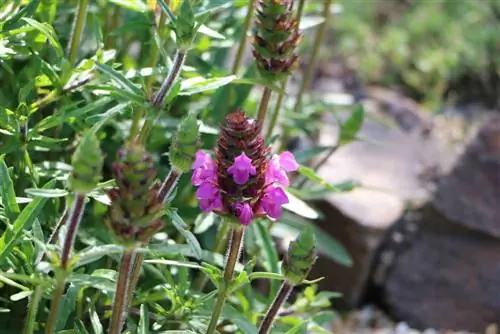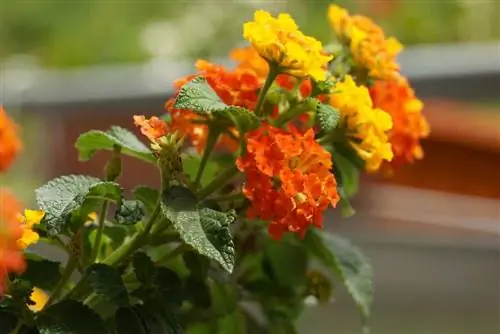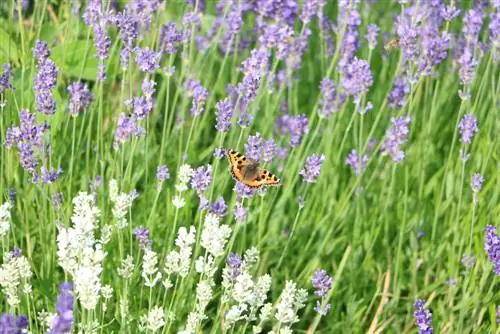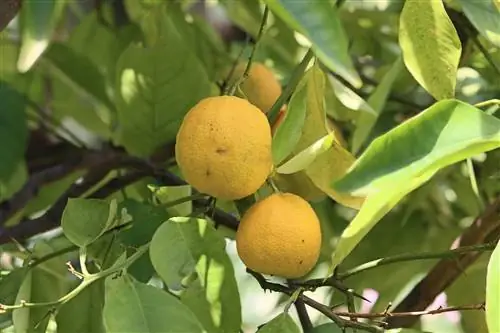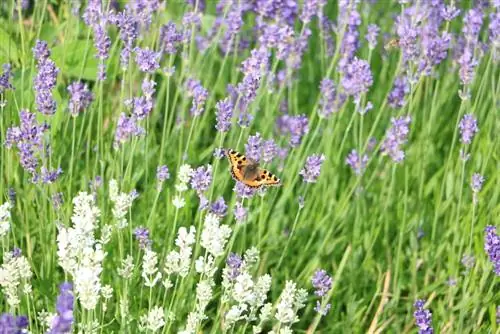- Author admin [email protected].
- Public 2023-12-17 03:39.
- Last modified 2025-01-24 12:45.
Crested lavender (Lavandula stoechas) is one of the 25-30 species of lavender worldwide and belongs to the Lamiaceae (lamiaceae) family. The name Stoechas is related to the Stoichads, the French island group of d'Hyères in the Mediterranean. In fact, wild lavender grows on Porquerolles, Port-Cros and Île du Levant. It is also known as maritime lavender, Italian lavender and Arabian lavender. The latter is explained by the fact that lavender was previously valued as a medicinal plant in the Arab world.
Appearance
The purple bracts of the lavender, which are arranged in eye-catching clusters, evoke associations with rabbit ears or butterflies. The shape of its attractive inflorescence is reminiscent of a pineapple. Due to its particularly long flowering period from May to September, it is a popular and grateful container plant. The flowers and leaves of lavender smell of camphor. Crested lavender is the wildest looking type of lavender.
Wild Crested Lavender
In contrast to the altitude-loving lavender species, real lavender and spit lavender, wild-growing lavender prefers to grow near the sea in sandy soils, which also explains its French name “Lavende maritime”.
Flavender is divided into two subspecies:
- Spanish lavender (Lavandula stoechas subsp. pedunculata, syn. L. pedunculata)
- Italian lavender (Lavandula stoechas subsp. stoechas)
The long-stemmed Spanish lavender grows wild in central Spain and northeastern Portugal and is more commonly cultivated than the Italian lavender, which blooms on short stems and is originally native to the entire Mediterranean region. Other subspecies of lavender are common in Turkey and Portugal.
Cultivated lavender
Lavandula stoechas is popular in this country as a pot plant, although both real lavender (Angustifolia) and spiking lavender (Latifolia) are more common. However, the commercial cultivation of lavender is quite complex and time-consuming and is therefore rarely practiced in Europe. The main commercial growing area for lavender is India.
The oil of lavender
The essential oil of lavender has a strong and almost pungent scent, similar to that of spit lavender, and appears neither as mild nor as aromatic and complex as that of real lavender. It is reminiscent of the scent of pine trees. Like the Speiklavender, Schopflavender has a comparatively high camphor content and has an antibacterial effect. Crested lavender is used accordingly in medicine. The quality of the effectiveness of lavender depends on the location, climate and other factors that influence cultivation.
Use leaves and flowers
The leaves of the lavender are suitable for seasoning fish and poultry. For this purpose they can be harvested from summer onwards without harming the plant. An antispasmodic and nerve-strengthening tea can be prepared from the flowers of the lavender. Scented sachets filled with the dried flowers of lavender are ideal for warding off annoying insects.
Demands on location and plant substrate
Lavender thrives best in full sun. In its location, the lavender should be exposed to full sun for at least four hours a day. The plant can be left in its location as long as the temperature does not drop below three degrees. Soil that is too rich in nutrients can inhibit the flower growth of lavender. It requires a well-drained and lime-free plant substrate. Ideal for this type of lavender is potting soil mixed with sand (mixing ratio 2 parts potting soil to 1 part sand or pumice gravel). Commercially available cactus soil and clay granules are also well suited as a substrate. Since lavender is only partially frost hardy, it should not be planted outdoors, but in a pot.
Plants
Lavandula stoechas can be planted in flower pots, balcony boxes or in containers in spring. The planter should be equipped with holes in the bottom that allow excess moisture to drain away. The container should be filled with a layer of clay shards or hydro grains, followed by the planting substrate. The root ball of the lavender must be placed at the right height so that it is completely covered. Press the substrate well. Immediately after planting, the lavender should be watered and placed in full sun.
Suitable planters for lavender
- Flowerpots
- Balcony boxes
- big scoops in buckets
- Ongoing care
- always keep dry, but do not let it dry out completely
- water when the top layer of soil has dried
- Avoid waterlogging
- Remove wilted inflorescences regularly
- Fertilization is hardly necessary
- Provide some liquid fertilizer only if flowering continues to decline
Cutting
Flower lavender should be cut back heavily in early spring (February to March) when it begins to sprout. Regular pruning for rejuvenation counteracts the woodiness and baldness of the plant. A vigorous pruning, which is carried out before the growth phase, also promotes the growth of the plant and increases its ability to bloom.
- In spring, cut the plant back to half to two-thirds of its total height
- It is not allowed to cut into old wood
Wintering
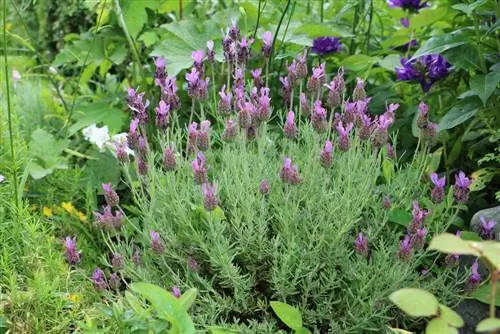
As an evergreen plant, lavender should be overwintered brightly and frost-free. A bright, unheated and frost-free garage or stairwell, for example, are suitable winter quarters. Under no circumstances should the temperature in the wintering room fall below -10 degrees Celsius, otherwise the lavender will freeze. From February onwards it would like to be warmer and in full sun again. To prepare it for the move outside and to avoid burning the leaves, the potted plant can be slowly hardened off. So it is advisable to initially only put them outside on a cloudy day or to place them there in the shade.
Profile
- Perennial and perennial herb
- Not hardy
- Up to 100 cm height
- Flower color pink to light purple
- Flowering period July to September
- fragrant plant
- potted plant
- Lime-free culture required
Claims of lavender
The demands of lavender can only be compared to a limited extent with those of real lavender. It also likes full sun, but prefers to be kept dry without drying out. Watering in moderation is therefore optimal. Watering is only done when the top layer of soil is already dry. However, water should never remain in the saucer of flower pots and buckets. The crested lavender, botanically also called Lavandula stoechas, takes to waterlogging quickly and for a long time.
The lavender also has its own requirements when it comes to the soil: the soil is well suited for this flowering plant if it is rarely fertilized and is not alkaline or…is calcareous. If a little fertilization is required due to declining flowering, the substrate must not be calcareous. By the way, the lavender will produce fewer flowers even if the soil is too rich in nutrients - you could almost call it ungrateful in this regard.
Flavender and its winter care
When it comes to lavender, winter care is just as important as regular pruning. When it comes to winter hardiness, lavender only lasts down to around -5 °C. Anything below this should be avoided. It is better to spend the winter as an evergreen shrub in a bright, frost-free greenhouse or in another cool place. An unheated garage is just as suitable for this as a barn or a bright cellar.
From February onwards, the lavender can go outside again: initially protected from night frost, it now really likes the increasing sun. However, if it is taken out later, it should be placed outside on cloudy days or protected from wind and weather to avoid burns from the often underestimated spring sun.
Don’t forget to prune
Pruning the lavender should be carried out in early spring as soon as the shoots become visible. However, do not proceed timidly, but simply cut back half to two thirds. The old wood should not be damaged, just a rejuvenation of the actual herb so that the plant does not become woody or even bald. Pruning the lavender rewards the garden lover with a strong, new blossom in late summer, which brings aromatic lavender magic into the garden.

